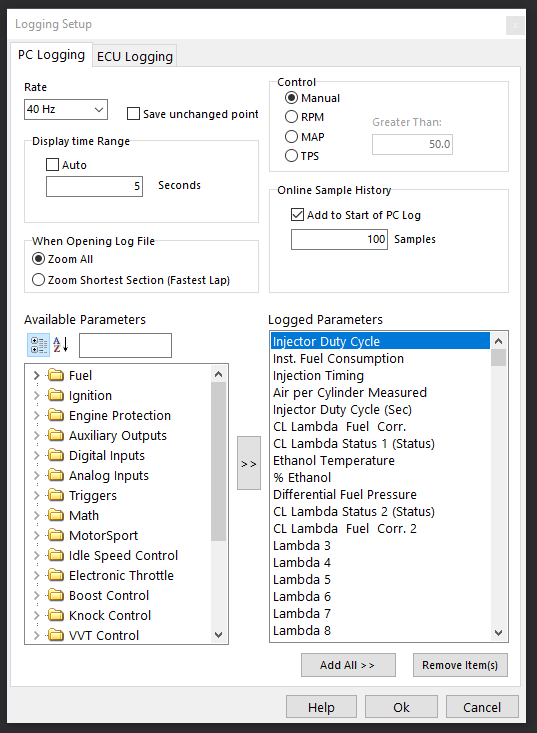There are two types of data logging, PC Logging and ECU Logging. The key difference is which device captures the data log. PC Logging allows you to capture log files directly onto your PC. Log files can be captured manually or automatically based on user configurable conditions.
Setting up PC Logging
The following setup window can be accessed by selecting 'Setup PC Logging' in the 'Logging' drop down menu.

Logging Setup Window
The following actions can be performed when opening a log file:
·Zoom All - Display the entire file
·Zoom Shortest Section - Display the shortest section (fastest lap or drag run).
The Online Sample History is a background buffer of previous parameter values (samples) that fills while connected to an ECU. A number of previous samples for each parameter is stored. It is these values that are used to display the snake trail on tables. As there is always a running history these samples can automatically be added to the start of a log file when recording if required. This is useful for if something unusual happens but logging was not recording. The F8 key can quickly be pressed and the history will be added to the recorded log possibly showing the unusual event in the log. The following options are available for setting up the sample history:
·Samples - The number of previous values recorded.
·Add to Start of PC Log - Select if it is desired that the history buffer be added to the start of new recorded files.
The length of the history buffer is not dependant on the selected logging rate. The history is logged at the maximum rate the PC to ECU connection is capable of.
Note: The length of the sample history buffer also affects the length of the table snake trail.
Selecting the Parameters to Log
Parameters can be added to the 'Logged Parameters' list on the right. To do this either double click on the required parameters or click the '>>' button to transfer them into the list. Parameters can be removed by highlighting them and clicking 'Remove Item(s)'.
Note: Click "Add All" to log everything.
The display time range can be set to either auto or manual.
·When auto is selected, the time plot views will keep adjusting their zoom to show the entire log file as it is being recorded.
·When auto is unchecked, the number of seconds specified in the box below will be the amount of time displayed on the time plot view as the log is being recorded.
The rate defines how many samples per second of each parameter the PC will try and sample. If the selected rate is higher than the current data rate, the sample rate will be reduced to the data rate.
Save unchanged points
With this checkbox active PCLink will record all data points, even if the data does not change, this can lead to a much larger log file. With the checkbox in-active PCLink will only record a new data point when a parameter has changed, this leads to much small log files and is recommended.
There are two main types of logging control, manual and automatic. Manual control gives the user full control over when the PC Logging is active. In auto mode the system can be setup so the logging becomes active when a condition is met. The conditions can be either RPM, MAP or TP is greater than X value. X is the value in the 'Automatic Logging Start Condition'.
Operating PC Logging
Once PC Logging has been configured, there are three possible states:
·PC Log = Off - PC Logging is inactive.
·PC Log = Record - Log file is being recorded
·PC Log = Play - Log file is playing back
The current state is displayed at the bottom left of the screen.
In manual operation logging is controlled by the F8 Key or using the Start/Stop options in the Logging drop down menu.
Recording can be controlled automatically. In automatic operation the logging recording state is controlled by the start condition specified in the setup. Setup the conditions upon which to start/stop logging in the PC Logging Setup menu.


